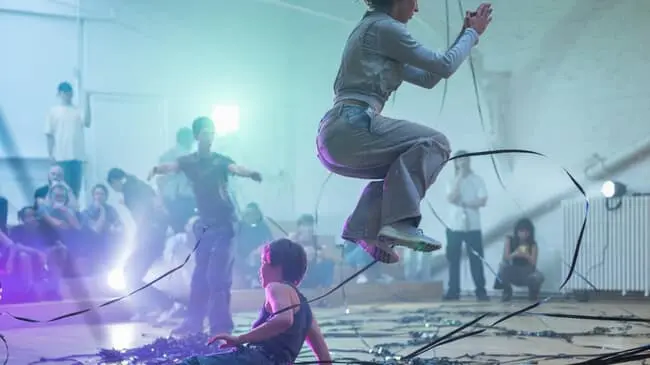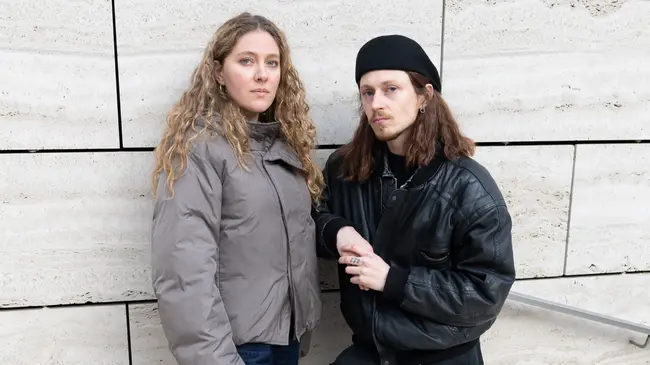An apple can’t be tired

Pieter Jennes is a painter based in Antwerp. His paintings are a collage of impressions and a homage to the little absurdities that shape our everyday life. Colours and shapes resonate in the stories, the moments, and the starting points for his work. What are his characters talking about? Are they discussing something important or just talking nonsense? Pieter guides us through his work, showing us a collection of narratives and anecdotes.
I’m curious to hear the stories behind your works. What was the story behind The Garden Hose for example?
The story of this painting is about the Bulldozer exhibition of 1973 in Moscow. It was organised by a group of underground—‘underground’ because their art was seen as modern, art was supposed to serve society back then—artists that were not members of the Russian artists’ union. The city didn’t allow them to use any exhibition spaces, so the group found themselves a patch of land outside of the city. The day they arrived with their work to set up the exhibition, a group of policemen awaited them. The police started spraying water canons and drove bulldozers over their paintings (hence the exhibition’s title). They apparently also tried to burn the paintings down. Although it’s a very political story, I am more interested in the visualisation of what happened. I don’t want to make political statements, I prefer to paint a contemporary, romanticised narrative.
How do you tell a story through your exhibition?
I always have a few big pieces that I use to tell a story when I create a new exhibition. I try to fit smaller paintings between the big ones because I don’t merely feel like making power statements. You can have nouns but if you want to make a sentence you also need adverbs, articles, and pronouns,... The big paintings wouldn’t stand as powerful in the space without the smaller pieces supporting them.
I don’t merely feel like making power statements
Is there a specific story that stuck with you?
Until the 1970s, there used to be a solitary, ancient tree that people used as a landmark in the desert of Niger. At a certain point, someone drove a car into it and the tree died. I think that is such a tragic story.
Your titles are stories in themselves! How do you choose those?
Looking for titles is a bit like buying something at the supermarket: let’s say oranges. While looking for them, I bump into a bunch of other products: milk, cornflakes, etc. By the time you’re checking out, your basket is filled with all kinds of ‘products’: stories, words, sentences, anecdotes,... you think you didn’t need it, but you end up using it anyway. There’s this one painting I made with a cat climbing in a tree, one on a branch, one being held by a man, and another one running out of the frame. But what are these cats actually doing in the woods? And is the guy rescuing the cat, or dumping it there? The title of the painting is Things That Happen When The Sun Goes Down. It sounds positive but also negative, it creates confusion. I want to give a direction to that confusion, not making it necessarily explanatory.
But it doesn’t always have to be difficult. ‘Fresh strawberries’ — the painting that is currently on view at Art Basel in Miami — is about a man that falls in front of a sign that says ‘fresh strawberries’. Therefore the titles are almost always an incentive for an atmosphere in the work.
The titles are almost always an incentive for an atmosphere
What meaning do the tiles have for you?
The tile pattern shows up in a lot of paintings, it’s a bit like the leftover tiles that you try to build a path within your backyard. You can use it as a road to walk from painting to painting. In combination with the geese, it becomes a big goose game. The same for the Grand Route markings on the trees: they appear in different works and you can use them to travel from painting to painting (or from collector’s to collector’s house). People falling from the sky.
What else, except for other paintings and artworks, brings you inspiration?
When it’s 4 am, after a party (usually the Foam party in Ranst), the moment that people are drunk enough they get encouraged to do stupid things, lose their teeth and try to jump off trash cans... These people in freefall form beautiful images. Then, very late, biking between the fields to get home feels quite like a hallucinatory experience. I think it’s also an echo of that.
These people in freefall form beautiful images
Different Class works with the interest of their community at heart.
Our work’s purpose is to foster a solid network for independent artists, those who love them, and those who want to support them. Become a member to contribute to the local Belgian art scene.






